| If you do
NOT see the Table of Contents frame to the left of this page, then Click here to open 'USArmyGermany' frameset |
||||||||||||||||||||||||||||||||||||||||||||||||||||||||||||
36th Field Artillery Group |
||||||||||||||||||||||||||||||||||||||||||||||||||||||||||||
|
|
||||||||||||||||||||||||||||||||||||||||||||||||||||||||||||
|
||||||||||||||||||||||||||||||||||||||||||||||||||||||||||||
|
|
||||||||||||||||||||||||||||||||||||||||||||||||||||||||||||
| Group History | ||||||||||||||||||||||||||||||||||||||||||||||||||||||||||||
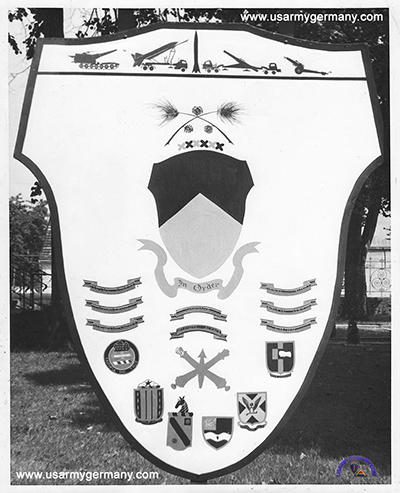 Sign in front of 36th Group headquarters building, Babenhausen (Stanley Bailin) |
||||||||||||||||||||||||||||||||||||||||||||||||||||||||||||
| 1951 - 1972 | ||||||||||||||||||||||||||||||||||||||||||||||||||||||||||||
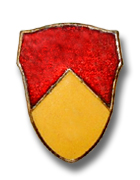 36th FA Group DI 36th FA Group DI |
||||||||||||||||||||||||||||||||||||||||||||||||||||||||||||
| (Sources: 36th Field Artillery Group, 1953) | ||||||||||||||||||||||||||||||||||||||||||||||||||||||||||||
|
||||||||||||||||||||||||||||||||||||||||||||||||||||||||||||
| Original Battalions Attached As of 1 April 1951, this Group had four battalions attached, with stations in Germany, as follows: |
||||||||||||||||||||||||||||||||||||||||||||||||||||||||||||
|
||||||||||||||||||||||||||||||||||||||||||||||||||||||||||||
| Changes Effective 16 May 1951, the 70th and 74th FA Battalions were relieved from attachment to this headquarters and shortly thereafter, the 443rd Antiaircraft Artillery Battalion (AW)(SP), located at Mainz, was attached to the Group. On 6 August 1951, the 18th Field Artillery Battalion and the 631st Armored Field Artillery Battalion, with stations at Babenhausen and Hammelburg, respectively, came under group attachment, and on 25 November, the Group lost the attached AAA battalion. Additional attachments to this headquarters during 1952 raised to six the total number of battalions attached to the Group. On 12 March 1952, the 597th Armored Field Artillery Battalion, with ultimate home station at Hanau, was attached. At about the same time, the 593rd Field Artillery Battalion, stationed at Nellingen, joined this headquarters. The 593rd moved to its permanent home station at Babenhausen on 30 July, placing three battalions in the same kaserne with Group headquarters. Current Battalions Attached The latest change made was that, effective 23 January 1953, the 631st Armd FA Bn was detached from the 36th Group (it was subsequently attached to the 142nd FA Group) and was replaced by the 594th Field Artillery Battalion, stationed at Sandhofen (Mannheim). As of this writing, therefore, 36th FA Group has the following attached units, with stations as shown: |
||||||||||||||||||||||||||||||||||||||||||||||||||||||||||||
|
||||||||||||||||||||||||||||||||||||||||||||||||||||||||||||
|
Commanding
Officer
Following the departure of Col Paul R. Weyrauch, Lt Col Cornelius A. Murphy assumed temporary command of the Group on 14 April 1952. Seven days later command was assumed by Col Robert N. Tyson who retains command at the present time. Training In training exercises conducted in the US Zone of Germany during the past few years, the 36th Field Artillery Group has acquired am excellent reputation. The high professional standards of training and operation evidenced by the group and its attached units has drawn many favorable comments from Senior Commanders. It appears that the group motto, "In Order" has guided the unit in its actions and that it is the goal of all personnel to maintain all things "in order" at all times. |
||||||||||||||||||||||||||||||||||||||||||||||||||||||||||||
|
(1)
The 517th FA Battalion was activated on 20 May 1949 at Sonthofen,
Germany. On 10 September 1951, the Bn was reorganized and redesignated
as the 517th Armored Field Artillery Battalion. On 4 April 1955,
the Bn was inactivated at Büdingen, Germany.
The 519th FA Battalion was activated on 20 May 1949 at Sonthofen, Germany. On 25 June 1958, the Bn was inactivated at Fort Lewis, Washington. |
||||||||||||||||||||||||||||||||||||||||||||||||||||||||||||
| If you have more
information on the history or organization of the 36th FA Group (or
any of the subordinate units), please contact me |
||||||||||||||||||||||||||||||||||||||||||||||||||||||||||||
|
|
||||||||||||||||||||||||||||||||||||||||||||||||||||||||||||
|
(Sources:
36th Field Artillery Group, 1954)
|
||||||||||||||||||||||||||||||||||||||||||||||||||||||||||||
|
||||||||||||||||||||||||||||||||||||||||||||||||||||||||||||
|
As
of June 1954, the 36th FA Group has the following attached units,
with stations as shown:
|
||||||||||||||||||||||||||||||||||||||||||||||||||||||||||||
|
||||||||||||||||||||||||||||||||||||||||||||||||||||||||||||
|
|
||||||||||||||||||||||||||||||||||||||||||||||||||||||||||||
(Source: Email from
Denise Campbell-Wicker, daughter of
Sgt Steward G. Campbell) |
||||||||||||||||||||||||||||||||||||||||||||||||||||||||||||
|
||||||||||||||||||||||||||||||||||||||||||||||||||||||||||||
|
||||||||||||||||||||||||||||||||||||||||||||||||||||||||||||
|
(Source:
Email from James Gray, HQ Co, 36th FA Gp, Aschaffenburg)
|
||||||||||||||||||||||||||||||||||||||||||||||||||||||||||||
|
I
was with the 36th FA Group Hdqs Co. in Aschaffenburg, Germany. We
were not stationed in Babenhausen. I am in the Group picture, third
from the right, fourth row standing. I was Radio Repair and we had
to maintain two separate radio nets.
I arrived in July, 1951 and left in November 1952. Also, the 18th Battalion and the 519th were stationed in Aschaffenburg with us, not in Babenhausen. I have a picture of me by the Company Directory listing the the locations of the afore-mentioned Battalions. (See photo series below) James Gray |
||||||||||||||||||||||||||||||||||||||||||||||||||||||||||||
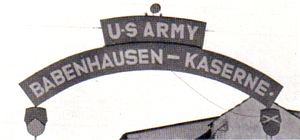 Sign over main gate, Babenhausen Ksn, 1954 |
||||||||||||||||||||||||||||||||||||||||||||||||||||||||||||
|
|
||||||||||||||||||||||||||||||||||||||||||||||||||||||||||||
|
(Source:
Email from Wayne E. Dixon, 7732 FA Gp and 36th FA Gp)
|
||||||||||||||||||||||||||||||||||||||||||||||||||||||||||||
|
||||||||||||||||||||||||||||||||||||||||||||||||||||||||||||
| I was a very
impressionable person having been so young and the first time really
away from home. I loved the mountains and the country around the station.
I was told that the German Army had used the burg as the German West
Point before we had taken over the post. The Constabulary had closed
their School and quite a few of the troops were assigned into the
Artillery units there. I was returned back down to Sonthofen from Wetzlar, and assigned to Group Headquarters. The 7732 Field Artillery Group was re-designated as the 36th FA Group and moved to the town of Babenhausen south of Frankfurt, between Darmstadt and Aschaffenburg. While assigned to the 36th, I worked in the S-2/3, and assigned as the Colonel's driver. After my re-enlistement I was sent to Murnau to attend Surveying School. We were re-assigned from the Constabulary and assigned to 7th Army. I remained with Group Headquarters till I volunteered for Korea in 1953 and was transferred to the 28th Infantry Division for advanced refresher before shipping over to Korea. |
||||||||||||||||||||||||||||||||||||||||||||||||||||||||||||
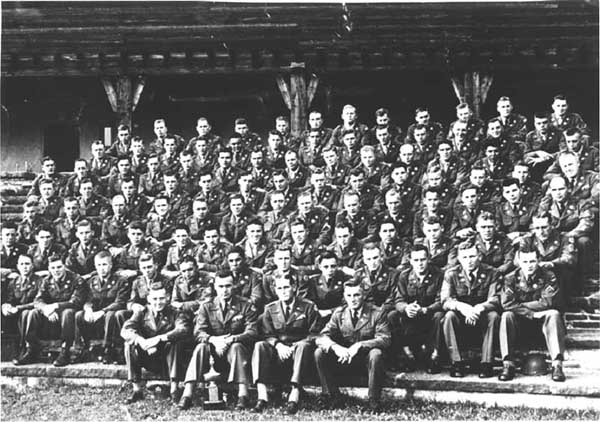 Group photo of "A" Battery, 94th Field Artillery Battalion (US CON), Sonthofen |
||||||||||||||||||||||||||||||||||||||||||||||||||||||||||||
|
|
||||||||||||||||||||||||||||||||||||||||||||||||||||||||||||
| Commanding Officers of the 36th FA Group, Babenhausen, Germany | ||||||||||||||||||||||||||||||||||||||||||||||||||||||||||||
| (Source: Information was submitted by Walter Duke who is a member of the Babenhausen Veterans & Friends. The group is an association of former members of the US Army who served there between 1950 - 1972. It also includes members of the teachers and the Civilian Technical reps.) | ||||||||||||||||||||||||||||||||||||||||||||||||||||||||||||
|
||||||||||||||||||||||||||||||||||||||||||||||||||||||||||||
| Commanders of the 36th FA Group and subordinate units - Summer 1954 | ||||||||||||||||||||||||||||||||||||||||||||||||||||||||||||
| (Source: 36th Field Artillery Group, Germany, 1954 Yearbook; information was submitted to me by Carl Dunn, who was in one or another of the battalions in the 36th FA Group from its activation in Apr 1951 until he left in Aug 1954 (517th FA Bn and then 597th FA Bn) | ||||||||||||||||||||||||||||||||||||||||||||||||||||||||||||
|
||||||||||||||||||||||||||||||||||||||||||||||||||||||||||||
(Source: Author's private collection) |
||||||||||||||||||||||||||||||||||||||||||||||||||||||||||||
PENTOMIC Changes - 1957/58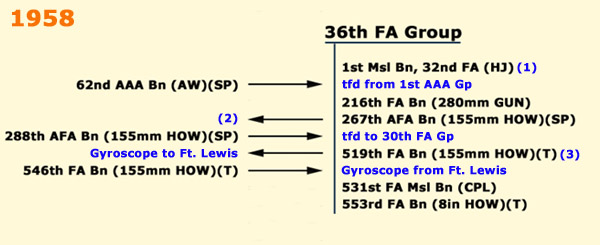 |
||||||||||||||||||||||||||||||||||||||||||||||||||||||||||||
| (1) Effective 1 July, 1957 - USAREUR's four FA Rkt Batteries were reorganized as battalions; 7th FA Rkt Btry reorganized and redesignated as 1st Msl Bn, 32nd FA (HJ)? (2) 267th AFA Bn inactivated in Germany on 1 Dec 1957; probably replaced at the same time by the 288th AFA Bn (3) 519th FA Bn and 546th FA Bn switched places under Operation Gyroscope. |
||||||||||||||||||||||||||||||||||||||||||||||||||||||||||||
ORGANIZATION (30 June 1958): |
||||||||||||||||||||||||||||||||||||||||||||||||||||||||||||
|
||||||||||||||||||||||||||||||||||||||||||||||||||||||||||||
| [1] STATION LIST, 30 June 1958 | ||||||||||||||||||||||||||||||||||||||||||||||||||||||||||||
|
|
||||||||||||||||||||||||||||||||||||||||||||||||||||||||||||
1958 |
||||||||||||||||||||||||||||||||||||||||||||||||||||||||||||
(Source STARS & STRIPES, February 9, 1958) |
||||||||||||||||||||||||||||||||||||||||||||||||||||||||||||
The 62nd AAA Bn, the oldest combat unit in USAREUR, has been transferred to 36th FA Group. The battalion was previously with V Corps Artillery. |
||||||||||||||||||||||||||||||||||||||||||||||||||||||||||||
(Source: Email from Meredith Hull (Bailin). daughter of Stanley Bailin, Army photographer for the 36th FA Group, 1959-1961) |
||||||||||||||||||||||||||||||||||||||||||||||||||||||||||||
1960 |
||||||||||||||||||||||||||||||||||||||||||||||||||||||||||||
(Source: Email from George Vanover, HQ 36th Arty Gp, 1959-60) |
||||||||||||||||||||||||||||||||||||||||||||||||||||||||||||
|
||||||||||||||||||||||||||||||||||||||||||||||||||||||||||||
1962 |
||||||||||||||||||||||||||||||||||||||||||||||||||||||||||||
(Source: Email from Walt Leon, HHB 36th FA Gp, 1962-64) |
||||||||||||||||||||||||||||||||||||||||||||||||||||||||||||
(Also see Walt's photos of the Predient Kennedy visit at Fliegerhorst Kaserne, June 1963.) I have a bunch of pictures of the Kaserne and other stuff. Near as I can tell, the pictures of what everyone is calling the barracks is where the HQ Administration building was, S-1, S-2, S-3, S-4 and Communications. I was the Kaserne commander's clerk (who was also known as the group commander, 36 FA Gp) - he was a bird colonel and senior office on the kaserne. When I first arrived it was Col. George P. Curtin followed by Albert E. Hunter and then Thurman Irving. I must confess that most of the pictures (I am sending) are from the right side (northwestern corner) of the Kaserne near the main gate. I seldom got to the other end of the place. A few months before my discharge I made Spec 5 so I got over as far as the NCO club; I was in the officer's club a few times to deliver messages from the colonel; and once I was invited to dinner by the S-4 Sergeant in the family living quarters. I first arrived in Germany at Frankfurt. We all thought were were going to be in V Corps. I spent a couple of days there and was further assigned to HQ Company, Special Troops, Heidelberg. I actually interviewed for the steno job with General Paul L. Freeman Jr. who was the Commanding General of United States Army, Europe. Obviously I wasn't selected. I was then assigned to the P&A Division of HQ USAREUR.Heidelberg is probably the best city in Germany to be stationed. German national KPs; an EM club that has entertainment such as Sam Cook (60's you remember?) and other like him; a city rich in history and not touched by allied bombs during WWII because it was allied HQ then. When I got orders to go to Babenhausen only after 30 days I was crushed. I guess someone didn't like me there. I arrived at Babenhausen in Aug of 1962. I found that I would be the S-1 clerk, which was also the personal clerk to the group commander a.k.a. Kaserne Coordinator since he was the highest-ranking officer on the Kaserne. Without question I was blessed with privilege in that the Adjutant, Sergeant Major, XO and Commander wanted me there constantly. As a result I was exempt from guard duty and KP. This wasn't something I asked for and every time we got a new Battery CO or first sergeant I found my name on both rosters. Not once did I ever complain or report this to the sergeant major. I simply reported for duty. In most occasions the battery CO was called and was told to get my but back to the office that correspondence was piling up and I was needed to take the never ending barrage of phone calls. Although this was none of my doing it generated a lot of dislike for me.Every day the colonel's orderly of the guard was sent to the sergeant major's office, which I also shared. We instructed him to first report to the colonel and introduce himself and n how to make coffee and to periodically check on the colonel to see if he wanted any. Other than that the colonel's order had a great, do nothing day but occasionally was used for gofer chores.When we got a new battery commander I noticed my name on the guard roster. I never told or complained to anyone at the HQ building. The night before I spent hours spit shining my boots and when I reported for duty I was standing tall. Staff Sergeant Ira Walton was the supply sergeant and made sure I got my M-14 in plenty of time to get it spotless. Guess what! I was selected as colonel's orderly. When I reported to the good old Sergeant Major Megahee he broke out in hysterical laughter because he tried to get me off the roster and since the adjutant was off that day, the battery CO over-ruled him. After he finished laughing he told me to sit my ass down and get to work.When I first arrived at Babenhausen, Colonel George P. Curtin was the commander. He was a John Wayne type; weathered face, soft spoken and respected by all. When he left Colonel Albert E. Hunter replaced him. Colonel Hunter while an Artillery officer was a real "Officer and a Gentleman" type. He was frequently condescending and loved to wear his dress uniform. Never once did I see Colonel Curtin in his greens or blues. Colonel Hunter loved his picture taken by our PIO specialist. Hunter frequently held the formal military dinners known as "Dine-ins." We had a couple of reams of Special 36th Arty Group stationery with the crest etc. I would have to type individual letters to all the officers invited to these dine-ins on the special paper. In the body of the letter he would inform the recipients who the president was (always him) and who Mr. Vice was. Mr. Vice was generally a junior officer who according to protocol had to say certain things and other various duties? The tradition is ancient and I am sure they had fun - dah? Look up the protocol for a formal "dine-in."Colonel Hunter was also a "resume" guy. At the time the "Army Commendation Medal" was (and I am quoting from the Army description) "The medal is awarded to any member of the Armed Forces of the United States who distinguishes himself or herself by meritorious achievement or service. The degree of meritorious service must be the same as that required for the Bronze Star or Air Medal, but does not involve military operations against an armed enemy. (ANF) In that I typed all recommendations for awards I know that this award was a necessary item for an upcoming officer's resume. Colonel Hunter seemed to recommend every battalion commander and or above average battery commander in his group and at times we had as many as 5 battalions under our command. I know of none that were not eventually approved. In my 28 months I only saw one enlisted man that received the Army Commendation Medal. I noticed the new list of past commanders of the 36th Group that you recently added. I had forgotten about little old LTC Robert E. Cleveland. He served as CO until Col Hunter came on board and then served as XO during most of my tour. He was replaced sometime in 1964 by a LTC Kusick (sp?) as XO. |
||||||||||||||||||||||||||||||||||||||||||||||||||||||||||||
|
||||||||||||||||||||||||||||||||||||||||||||||||||||||||||||
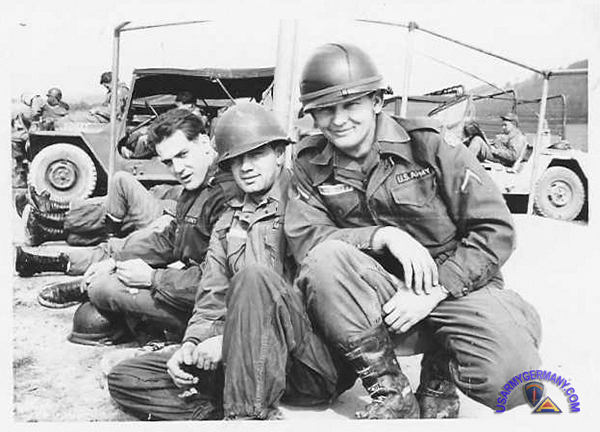 Chester Wright (middle), during a rest stop on the way to Graf with A Btry, 1st TAB, 26th Arty |
||||||||||||||||||||||||||||||||||||||||||||||||||||||||||||
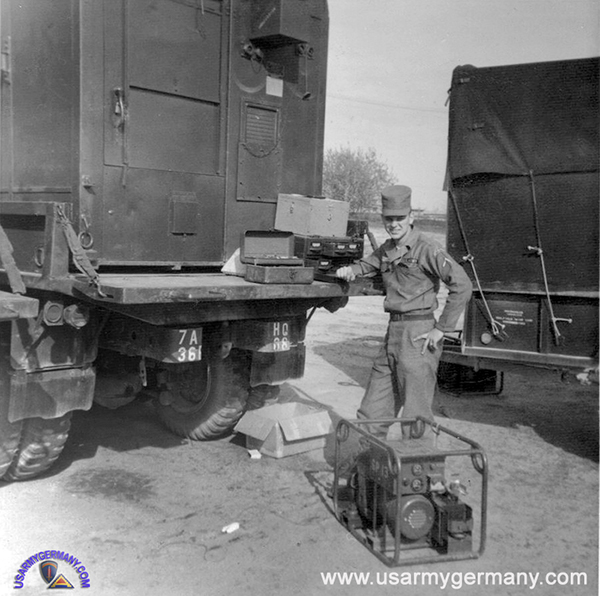 Unnamed 36th Gp radio repairman stands next to 26D RATT rig (Chester Wright) |
||||||||||||||||||||||||||||||||||||||||||||||||||||||||||||
1964 |
||||||||||||||||||||||||||||||||||||||||||||||||||||||||||||
(Source: Email from Chester Wright, HHB 36th FA Gp and A Btry, 1st TAB, 26th Arty, 1962-65) |
||||||||||||||||||||||||||||||||||||||||||||||||||||||||||||
On your site which I recently discovered, I was looking for info on 36th FA GP and A Btry 1st TAB 26th Arty. I found both, but it does not match info that I know for a fact. Unless of course I am misinterpreting the reference in your info. I was with A Btry 1st TAB 26th Arty until Aug 29th, 1965, and it was in Aschaffenburg, Fiori Barracks at that time, NOT Darmstadt, but as I recall the unit had been there for only a short time before I arrived. Prior to A Btry 1st TAB 26th Arty, I was with the 36th FA GP, HQ & HQ Btry in Babenhausen. I have learned from reading on different sites similar to yours that there were other 1st TAB 26th Arty Btrys, e.g. B, C. I arrived in Germany about August 1962 and was with the 36th FA GP, HQ & HQ Btry until I went to 1st TAB 26th Arty A Btry in late 1964 or early 1965. Actually I have been trying to find out exactly when I was transferred. I have no paperwork that refers to that move. So other than the apparent error of location of A Btry 1st TAB 26th Arty, as much as my memory serves me, the rest of the info that you show in the 1965 Order of Battle for Non-Divisional Artillery in 7th Army (see Overview Page, Field Artillery) is correct. When I was at 36th Arty GP, the units listed, other than the 26th were all assigned to 36th FA GP. Plus a few others that came and went during my tour of duty. Others such as 2nd Bn 92nd FA, 2nd Bn 38th Arty, or possibly 1st Bn 38th Arty. I think they had a 280mm that was hauled by two rigs, one on each end. Thanks for your website. (Webmaster note: I checked a copy of the USAREUR Station List for 30 June 1964 - shows A Btry at Fiori Barracks, Aschaffenburg APO 162 (the whole battalion is there at that time - HHC, A, B, & C Batteries). The next SL I have is for 31 March 1965: it shows no HHC (prob inactivated); A Btry at Ludwig Ksn, Darmstadt, APO 175; B Btry at Francois Ksn, Hanau, APO 165; and C Btry at Fiori Bks, Aschaffenburg, APO 162. And the SL for 30 June 1965 shows no C Btry (prob inactivated); A Btry at Ludwig Ksn, Darmstadt and B Btry at Francois Ksn, Hanau.) |
||||||||||||||||||||||||||||||||||||||||||||||||||||||||||||
1968-69 |
||||||||||||||||||||||||||||||||||||||||||||||||||||||||||||
| (Source: General Donald R. Keith - Oral History Transcript, USAMHI) | ||||||||||||||||||||||||||||||||||||||||||||||||||||||||||||
The 36th FA Group was comprised of a 175mm gun battalion, an 8" howitzer battalion, an Honest John battalion, two Sergeant battalions, and two target acquisition batteries. Col. Keith was the Group commander. |
||||||||||||||||||||||||||||||||||||||||||||||||||||||||||||
| (Source: STATION LIST, 30 June 1968) | ||||||||||||||||||||||||||||||||||||||||||||||||||||||||||||
| ORGANIZATION (1968) | ||||||||||||||||||||||||||||||||||||||||||||||||||||||||||||
|
||||||||||||||||||||||||||||||||||||||||||||||||||||||||||||
| (Source: Email from Robert Austin (2nd Bn, 5th FA) via Walter Duke, Babenhausen Veterans & Friends) | ||||||||||||||||||||||||||||||||||||||||||||||||||||||||||||
| In 1971, we cross-trained with the British 20th Regiment, Royal Artillery. Unit was from vicinity of Halle (Northern Germany}. Really a once in a lifetime experience. Unit was 107 equipped. We were co-located and billeted together. They really knew how to go to the field. Brought their own NAFE (Px) tents. Had two large circus like tents for Officer and EM clubs. They even brought their trophies and portable bars. Unit was very well trained. In fact, the SGM stated that it was a regular army regiment and some of the personnel would spend their entire military service in the same unit. Youngest member of the regiment had been there over 6 years. Another surprise was the unit was able to perform 3d echelon maintenance internally. Additionally, when moving from FP to FP they did not convoy. Instead, they moved one piece forward and when it was ready to fire, moved each piece forward individually and the FDC track was last track to move. Troops enjoyed the off time and the British beat us in cricket and we won the soft ball and Horse shoes. Top photo - LTC Peter Ferry, (CO British 20th Arty Regiment), CSM Robert Austin,(2nd Bn, 5th Arty) Bottom photo - BG Catrona V Corps,COL Cronin(36th Gp),LTC Peter Ferry 20th(Bn CO), LTC Knight (2/5 CO) and Maj Furno. |
||||||||||||||||||||||||||||||||||||||||||||||||||||||||||||
|
||||||||||||||||||||||||||||||||||||||||||||||||||||||||||||
| 216th FA Bn (280mm Gun) - 2nd Gun Bn, 38th Arty | ||||||||||||||||||||||||||||||||||||||||||||||||||||||||||||
| See more on the 216th FA Bn/2nd Gun Bn, 38th FA on the 212th FA Group Page | ||||||||||||||||||||||||||||||||||||||||||||||||||||||||||||
| (Source: Email from Marion R. Skaggs, B Btry, 216th FA Bn) | ||||||||||||||||||||||||||||||||||||||||||||||||||||||||||||
| I was a T-10 driver for B Btry 216 FA Bn in Germany. One time, I don't remember the date, we were driving down one of the small hard surface roads to a firing location. When we were going up a hill, a small car decided to try passing, another car topped the hill going in the other direction. All of a sudden, the little passing car disappeared. Once the car that came over the hill got by, the little car came out from under the gun and made his pass. It scared the hell out of the B Unit driver because the little car was there and all of a sudden it was gone. I came over with the 216th from Ft Sill, OK and left the Organization in Aug of 1956 for civilian life. It was a great Outfit and incidentally, was the only Outfit I ever shed a few tears over because I left all of my "brother's" there. In addition, after we arrived at Ernst Ludwig Kaserne, at Darmstadt, we had a "small" problem. I was moving my A Unit and my "walker" told me there was a rattling sound coming from my left rear tires. The motor pool Sargeant was notified and he inspecyed the tires. One of them had to be removed and tore down. We removed a 10" nail that one of the German Nationals had put in the tire at the "Depot" before we picked up the guns. Lucky, yes , it could have been a disaster if the tire had blown or gone flat at Autobahn speeds. I absolutely loved the Personnel of B Btry 216 FA Bn and would enjoy hearing from anyone who wants to write.That gun was one hell of a piece of machinery and I don't understand anybody that says it was "cumbersome". Sure it was heavy and bulky, but we never had any problems putting it where our C. O. Captain Richard Edwards wanted it to be. He always asked us T-10 drivers if we could put it where he wanted it and we would discuss the situation and tell him , yes or no. He would then tell us in plain english: "You sink my gun and I'll have your a-s". Then he would grin. |
||||||||||||||||||||||||||||||||||||||||||||||||||||||||||||
| ADDITIONAL INFORMATION I found a 1955 216th Thanksgiving Menu that had most of the unit commanders listed. If you want them, here they are. Bear in mind that these would be effective when the 216th arrived at Ernst Ludwig Karserne, Darmstadt, Germany in 1955. Our Batallion Co was Lt Col Ralph L. Todd; B Btry Co was Capt Richard R. Edwards; B Btry Exec Off. was 1st Lt. Otto N. Riley, First Sgt was SFC Robert A. White, Mess Sgt was SFC John T. Bottoms (an excellent cook by the way). Fire Direction Sect. Chief: SFC Frank B Hastie Jr; Inst & Survey Sect. Officer: 2nd Lt Donald E. Netzel, Recon Off.; SP3 Lawrence J Bergen, Chief of Sect. Radar Section; 2nd Lt Thomas C Linstrom, Radar Officer; S/Sgt Jack V Witt , Chief of Sect.& Cpl William Gregory, Asst Chief of Section; Wire Section (Communications) Sgt Charles K. Davis, Chief of Section.; 1st Gun Section Platoon Comdr. 2nd Lt Albert B. West, Sgt Clinton W. Primus, Chief of Section; 2nd Gun Section Platoon Comdr. 2nd Lt Herald K. Clizer, Sgt Ernest Little, Chief of Section; Motor Vehicle Chief of Section SFC Vernon E. Bishop; and Chief of Supply Section SFC Paul M. Hooper. |
||||||||||||||||||||||||||||||||||||||||||||||||||||||||||||
| (Source: Photo album submitted by the Commander, St Louis MEPS) | ||||||||||||||||||||||||||||||||||||||||||||||||||||||||||||
| (Source: Email from Greg Mahler, 2nd Gun Bn, 38th Arty (1959-62) and HHB, 36th FA Gp (1966)) | ||||||||||||||||||||||||||||||||||||||||||||||||||||||||||||
| My name is Gregory Mahler, CW3, US Army retired. My history with the 36th Arty Group goes all the way back to 1959 when as a SP4 I was assigned to HHB 2nd Bn 38th Arty located at Ernest Ludwig Kaserne, Darmstadt Germany. I was assigned to the Personnel Section and when I left in Nov 1962 I was a SGT E5 Personnel Sgt. At one time our unit was also assigned to Hqs 212th Arty Gp and also the 42nd Arty Gp but most of the time was with the 36th Arty Gp stationed in Babenhausen, Germany. During my time at the 2nd Bn 38th Arty we had as Battalion Commanders, LTC Wilcox,LTC Murphy and LTC Miller. Again in 1966 as a SSG E6 I was assigned to the 5th Bn 77th Arty Babenhuasen Germany under command of Hqs 36th Arty Gp. A few months after being assigned there to the 5/77 I was trf up the Group Hqs as Group Personnel Sgt. The Group Commander at that time was Col. Cabanas (spelled wrong), the adjutant was Major Tracy W. Griffin. After Col. Cabanas left for USAREUR Hqs, Col. Leslie Hardy became the Group Commander. I was assigned there until shortly after making SFC E7 I came down on orders for RVN. I would be really anxious to see any photos of the Kaserne during that period and hear from anyone that was stationed with the Group during that period |
||||||||||||||||||||||||||||||||||||||||||||||||||||||||||||
| (Source: Email from Frank Boyd) | ||||||||||||||||||||||||||||||||||||||||||||||||||||||||||||
The two years I served with the 2nd Gun Bn, 38th Field Artillery, was in 1962 & 1963. We went to Grafenwoehr & Vilseck twice a year: March and Sept. We also did border patrol at Fulda. That was up on a hill looking down on the East Germans in their tanks going by. Had good memories and was proud to be a member of the "Atomic Cannon."
I was in B Battery 1st gun section. Ammo. I also have a picture of the gun firing near Vilseck. If you want too put that in the 280mm section.
|
||||||||||||||||||||||||||||||||||||||||||||||||||||||||||||
| 531st FAM Bn (CPL) - 1st Msl Bn (Cpl), 38th Arty | ||||||||||||||||||||||||||||||||||||||||||||||||||||||||||||
| 531st Field Artillery Missile Battalion | ||||||||||||||||||||||||||||||||||||||||||||||||||||||||||||
 531st FA Missile Battalion DUI 531st FA Missile Battalion DUI |
||||||||||||||||||||||||||||||||||||||||||||||||||||||||||||
1956 |
||||||||||||||||||||||||||||||||||||||||||||||||||||||||||||
(Source: Email from Ralph Parris) |
||||||||||||||||||||||||||||||||||||||||||||||||||||||||||||
I was a member of the 531st FAM BN (CPL). We trained at Fort Bliss and then moved by ship to Germany in Jan 1956. We were stationed in Babenhausen. This is not what is shown on your site. I am pleased to find that there is a place on the web that at least mentions our existance. I am proud of my service in that unit. |
||||||||||||||||||||||||||||||||||||||||||||||||||||||||||||
| 1st Missile Battalion, 38th Artillery | ||||||||||||||||||||||||||||||||||||||||||||||||||||||||||||
 1st MSL Bn. 38th Artillery DUI 1st MSL Bn. 38th Artillery DUI |
||||||||||||||||||||||||||||||||||||||||||||||||||||||||||||
(Source: Webmaster's collection) |
||||||||||||||||||||||||||||||||||||||||||||||||||||||||||||
In the early months of 1956, the 1st Missile Battalion, 38th Artillery, formerly the 531st Field Artillery Missile Battalion, was sent overseas. With it came the CORPORAL Type II missile making it the first unit so equipped. The battalion was assigned to Seventh Army with the tactical mission of furnishing support to V Corps Artillery. Since its arrival in Europe as part of the NATO team, the battalion has been undergoing continued and extensive training both in the field and in garrison. The men and equipment of the "Steel behind the Rock" have presented demonstration of the CORPORAL missile to members of the NATO Alliance -- England, France, Germany, Italy, Turkey and The Netherlands. Displays have also been staged for the Seventh Army Commander's Conference, the NATO War College, and for students of several Target Analysis courses. On July 21, 1958 the 531st Field Artillery Battalion was deactivated and immediately reactivated as the 1st Missile Battalion of the 38th Artillery. |
||||||||||||||||||||||||||||||||||||||||||||||||||||||||||||
1960 |
||||||||||||||||||||||||||||||||||||||||||||||||||||||||||||
| (Source: Email from Art Bracher) | ||||||||||||||||||||||||||||||||||||||||||||||||||||||||||||
| I stumbled onto your website while looking for information on the various units to which I have been assigned. I service two tours with the Seventh Army. The first (1957-59) with the Seventh Army NCO Academy in Munich, and participated in the relocation to Bad Tölz. The second (1960-63) with the 1st Missile Bn (Corporal), 38th Artillery in Babenhausen, between Darmstadt and Aschaffensburg. We deactivated the 1/38 in 1962 (or early 63) and most of us moved on to 2nd Missile Bn (Corporal) 84th Artillery in Mainz/Gonsenheim. I was disappointed that neither of these battalions was included in your coverage of Field Artillery units in the 1950's and 1960's. |
||||||||||||||||||||||||||||||||||||||||||||||||||||||||||||
1961 |
||||||||||||||||||||||||||||||||||||||||||||||||||||||||||||
| (Source: Email from Neil P. Albaugh) | ||||||||||||||||||||||||||||||||||||||||||||||||||||||||||||
| One thing, Walter. Corporal missile units traditionally returned to the US for their missile firing practice. They went to Ft. Bliss and used the existing support vehicles and equipment there to fire a few missiles at the Ft. Bliss range and then returned to their post in Germany. As an experiment, this was changed one year (perhaps more than one year- I wasn’t there later) so the 1/38th Artillery and my 157th Ordnance Detachment were sent to a British missile range in the Outer Hebrides off the NW coast of Scotland. All of our equipment, including a radar van, Doppler radar van, computer van, and support vehicles together with all personnel were loaded into large USAF cargo planes in Rhein-Main USAFB and flown to the Benbecula Aerodrome where we landed. Landing was exciting - brakes, reversed props, and still we used all the available runway. We were billeted in the British barracks at the Royal Artillery Guided Weapons Range on South Uist. We ate in the British mess hall, mutton for breakfast, mutton for lunch, and mutton for dinner. I wouldn’t have survived if there had not been a tiny NAAFI store that sold Cadbury chocolate bars. We set up our equipment, ran a checkout, and fired a Corporal Type IIB out into the Atlantic at a designated point as a target. There was a British radar station on the tiny isolated island of St. Kitts that determined the missile accuracy and scored our launch as a hit. Our second launch a day or two later looked successful but as the missile reached a high altitude it exploded. We were very disappointed but later learned that a British Range Safety Officer had accidentally destroyed it. His “Destruct” switch was ON when he turned on his control but, as it was a vacuum tube circuit, it took some time to warm up and when it did it sent out a radio “destruct” command. Since that missile was on a correct trajectory, we were given credit for a hit. I should note that there was a Soviet “fishing trawler” out in the range impact area at the time but we were given orders to go ahead and fire anyway. Our last launch ran into problems. Ever wonder what happens after “5..4..3..2..1..FIRE”? and nothing happens? Its “A..B..C..D..” when that count reached ”J” the launch was aborted. Normally at launch, valves release the fuel (analine with a shot of furfuryl alcohol for starting) and oxidizer (red fuming nitric acid) from pressurized tanks inside the missile through burst diaphragms into the rocket motor combustion chamber, immediately starting to burn. Unfortunately, the fuel line burst diaphragm was defective and did not burst which allowed only the red fuming nitric acid (RFNA) to spray into the rocket motor. Not combusting, it simply sprayed out the nozzle on to the launcher and tail of the missile. Decontamination crews came in and rendered the site safe after a time and the 1/38 Artillery crew found that the RFNA had done major damage to the rear fins, where the servo mechanisms are located which steer the missile on its flight. Although this was far more serious damage than an Ordnance Direct Support unit would be normally called on to repair, my men worked through the whole night to fix the damage. In the morning we launched that “ruptured duck” with fingers crossed and probably a few prayers and it was also successful! We returned to Germany with upturned brooms tied to our vehicles as WW II submarines had done, signifying a “clean sweep. I was immensely proud of the job that we had done to contribute to our overall success. So much for “war stories”. Smile |
||||||||||||||||||||||||||||||||||||||||||||||||||||||||||||
 Babenhausen Kaserne, 2013 (Neil Albaugh) |
||||||||||||||||||||||||||||||||||||||||||||||||||||||||||||
 Babenhausen Kaserne, 2013 (Neil Albaugh) |
||||||||||||||||||||||||||||||||||||||||||||||||||||||||||||
|
||||||||||||||||||||||||||||||||||||||||||||||||||||||||||||
| 553rd FA Bn (8in How)(SP) - 3rd How Bn, 18th Arty | ||||||||||||||||||||||||||||||||||||||||||||||||||||||||||||
| 553rd Field Artillery Battalion | ||||||||||||||||||||||||||||||||||||||||||||||||||||||||||||
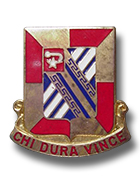 553rd Field Artillery Bn crest 553rd Field Artillery Bn crest |
||||||||||||||||||||||||||||||||||||||||||||||||||||||||||||
| (Source: HISTORY OF THE 553d FIELD ARTILLERY, written by Harold L Holland, 2000) | ||||||||||||||||||||||||||||||||||||||||||||||||||||||||||||
| Under Operation Gyroscope, the 553rd Field Artillery Battalion, Ft. Sill, OK, was ordered on January 19, 1956 to prepare for a unit transfer to Darmstadt, Germany. The advance party was to arrive by May 15, 1956 and the main body by July 12, 1956. Travel was accomplished aboard the USS General Alexander M. Patch. The unit to be replaced at Darmstadt was the 18th Field Artillery Bn. Once in Germany and under the command of the 36th Artillery Group (Babenhausen), the mission of the 553rd was to provide direct support to V Corps units and to maintain a constant state of combat readiness to protect the interest of NATO and 7th Army. In September of 1957 about 300 of the original men of the 553rd FA Bn were replaced by a packet of that same amount from Ft. Sill. |
||||||||||||||||||||||||||||||||||||||||||||||||||||||||||||
| 1958 | ||||||||||||||||||||||||||||||||||||||||||||||||||||||||||||
| (Source: Email from Richard Thornton) | ||||||||||||||||||||||||||||||||||||||||||||||||||||||||||||
| I was stationed at Ft Sill in 1957 with the 553rd FA. We were a Gyro unit that had been in basic training at Fort Leonard Wood in Missouri. Upon our completion of the 2nd eight at Ft Sill we went by Troop Train to the Brooklyn Terminal in NY.
Departed from NY Oct 1958 on the U.S.S. Darby. Landed in Bremerhaven Germany, from there by Bus to Darmstadt were we replaced the 18th F. A. Battalion. We were the 553 F.A, Battalion. The Honest John and Corporal missiles were assigned at the Ernest Ludwig Kaserne along with the 280 mm Cannon. I was with the HQ Battery of the 553rd. No mention anywhere of the 553 rd. The Battalion crest read Chi Dura Vinci he who endures conquers. Obviously we were all part of the 7th Army. |
||||||||||||||||||||||||||||||||||||||||||||||||||||||||||||
| 3rd Howitzer Battalion, 18th Artillery | ||||||||||||||||||||||||||||||||||||||||||||||||||||||||||||
| 1960 | ||||||||||||||||||||||||||||||||||||||||||||||||||||||||||||
| (Source: Email from George R. Hanselman) | ||||||||||||||||||||||||||||||||||||||||||||||||||||||||||||
| Just finished viewing your web page on USAREUR artillery. I was with the 3-18th Artillery in Darmstadt, Germany 1960-1963. We were an
8inch towed howitzer unit with nuclear capabilities. Also on our kaserne
was the 28th artillery, an Honest John unit and the 38th artillery, the
280mm Atomic Cannon. I found the information on your site very
interesting. Brought back memories from so long ago. Never had the
privilege of seeing either the 280mm or the Honest John being fired.
Spent quite a lot of time in Grafenwohr however. The 3rd of the 18th had a terrible accident at Graf on the 2nd or 3rd of Sept 1960. It fired a long round and several lives were lost. |
||||||||||||||||||||||||||||||||||||||||||||||||||||||||||||
| 594th FA Battalion (8in How)(SP) - 2nd How Bn, 92nd Arty | ||||||||||||||||||||||||||||||||||||||||||||||||||||||||||||
| 594th Field Artillery Battalion | ||||||||||||||||||||||||||||||||||||||||||||||||||||||||||||
| (Source: Unit History compiled in 2004 by Robert Shook and other former members of the 594th FA Bn) | ||||||||||||||||||||||||||||||||||||||||||||||||||||||||||||
|
||||||||||||||||||||||||||||||||||||||||||||||||||||||||||||
| (Source: Email from Jim Janowicz) | ||||||||||||||||||||||||||||||||||||||||||||||||||||||||||||
| Correction As I was doing a bit of research on artillery units in Germany during the 50's, I have found that in a number of places in the history the WRONG weapon being listed for the 594th Heavy Field Artillery unit in Giessen. From 1952 thru 1958 the CORRECT WEAPON SHOULD BE ----- 155mm Long Tom Gun SP ---- NOT a 155mm (HOW) SP. I was in the FIRE DIRECTION CENTER 1953 THRU 1956. Plus in 1955-56 our unit fired the highest score ever fired by a 7th Army Unit. We were even written up in the Stars & Stripes. |
||||||||||||||||||||||||||||||||||||||||||||||||||||||||||||
| (Source: Email from Joseph Diggs, 594th FA Bn) | ||||||||||||||||||||||||||||||||||||||||||||||||||||||||||||
| The 594th FA
Bn was reactivated in Octover 1950 at what was then Camp Polk, LA
as an all-Black unit while the Armed Forces were still segregated.
The battalion's first commander was Lt. Col. Harry A. Randle. The unit had five batteries: The armament was the 155mm gun. There were four guns in each firing battery. In February 1952, the battalion was deployed to Germany and was stationed at what was then known as Y-79 (and today is called Coleman Barracks) in Mannheim, Germany. Shortly thereafter, the unit was moved to Rivers Barracks in Giessen. It was still at Rivers when I left in October 1953. |
||||||||||||||||||||||||||||||||||||||||||||||||||||||||||||
|
|
||||||||||||||||||||||||||||||||||||||||||||||||||||||||||||
| (Sources: 142nd Field Artillery Group, Germany, 1954 and 36th Field Artillery Group, 1953) | ||||||||||||||||||||||||||||||||||||||||||||||||||||||||||||
| Upon the battalion's
arrival in Germany in February 1952, the 594th was initially attached
to the 142nd Field Artillery Group (stationed in Baumholder). In January 1953, the 142nd FA Group was moved to Wertheim. Effective 23 January 1953, a swap between the 142nd and 36th FA groups was effected. The 594th was relieved of attachment to the 142nd and attached to the 36th FA Group. Concurrently, the 631st Armd FA Bn was relieved of attachment to the 36th and attached to the 142nd FA Group. The new assignment necessitated the move of the 594th from Mannheim-Sandhofen to Giessen to be closer to the units it supported. |
||||||||||||||||||||||||||||||||||||||||||||||||||||||||||||
| 2nd Howitzer Battalion, 92nd Artillery | ||||||||||||||||||||||||||||||||||||||||||||||||||||||||||||
| 2nd How Bn, 92nd Arty | ||||||||||||||||||||||||||||||||||||||||||||||||||||||||||||
| (Source: Letter from Joseph Mondzak, 2nd How Bn, 92nd Arty; HHC 4th Logistical Cmd; 1st Bn, 94th Arty) | ||||||||||||||||||||||||||||||||||||||||||||||||||||||||||||
| As a very young First Lieutenant of Artillery I joined the 594th FA Bn in July 1958 at about the same time it was redesignated as the 2d Battalion, 92d Artillery. I remained with the 2/92 at Rivers Barracks until July 1961. The battalion was equipped with the M55 8-inch Howitzer, Self-Propelled. We did have a nuclear capability. I spent an enormous amount of time at Grafenwoehr either taking a DASA, DAIG, USAREUR, V Corps or ATT with my unit ... or serving as an inspector while a sister battalion was being tested. I remember vividly the horrible artillery accident at Grafenwohr on 2 September 1960 that killed 16 members of the 12th Cavalry and wounded 26 others. We were in a firing position less than one-half mile from the unit that fired the fatal round. I have some photographs from my tour with the 2/92 and would be happy to share them Some are poor quality and not suitable for scanning and emailing. Each is identified as to time and place. Enjoyed the web site very much. Good job. |
||||||||||||||||||||||||||||||||||||||||||||||||||||||||||||
|
||||||||||||||||||||||||||||||||||||||||||||||||||||||||||||
|
||||||||||||||||||||||||||||||||||||||||||||||||||||||||||||
|
|
||||||||||||||||||||||||||||||||||||||||||||||||||||||||||||
| 7th Field Artillery Battery (762mm Rocket) | ||||||||||||||||||||||||||||||||||||||||||||||||||||||||||||
| 1953 | ||||||||||||||||||||||||||||||||||||||||||||||||||||||||||||
|
(Source:
Letter from Bob Graziano, 7th FA Btry (Rkt), 1953-1955)
|
||||||||||||||||||||||||||||||||||||||||||||||||||||||||||||
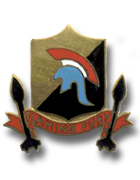 7th FA Battery (Rocket) DUI
7th FA Battery (Rocket) DUI |
||||||||||||||||||||||||||||||||||||||||||||||||||||||||||||
| I served with
the 7th FA Rkt Btry from its inception at Fort Sill, Okla.
and deployed with it to Germany in Oct 1954. I rotated back to the States in Oct 1955. I was
a chief of section of a radio crew. We were stationed in the Ernst Ludwig Kaserne. We were a "Bastard" outfit attached for finances to the 216th FA Bn. We were a 762mm Honest John Rocket Battery. This was a free-flight rocket capable of going 20 miles. We trained along with the Atomic Cannon and the standard 155mm guns. If I remember correctly we were part of V Corp Artillery. Has anyone ever heard of us? Currently, in front of an Armory in Wildwood NJ, sits an old Honest John Rocket and Launcher. I asked at the armory for a history of the weapon, but no one can give me one. Our outfit fired the first one of these weapons, outside of those fired at White Sands Proving Grounds. In fact I painted the name of the rocked before it was fired. Myself and another guy by the name of Charlie Mendez. Under the name on the rocket, we signed it with the name Menziano, incorporating both our names. I also designed the Unit Crest that appears on your Web page. Mr. Herbst was correct, the 7th had the honor of firing the first one. Last week I was able to contact another good buddy that I haven't spoken to in 50 years. Will get to see him in May. Understand now the Ernst Ludwig Kaserne in Darmstadt has been closed. Went back on a trip in 1987 and actually toured the post with my wife. A part of history is now gone. Thanks for keeping it alive. Bob Graziano |
||||||||||||||||||||||||||||||||||||||||||||||||||||||||||||
|
|
||||||||||||||||||||||||||||||||||||||||||||||||||||||||||||
|
(Source:
Letter from Henry E. Herbst, 7th FA Btry (Rkt), March 1954-Sept
1956)
|
||||||||||||||||||||||||||||||||||||||||||||||||||||||||||||
|
Individual History
I was sworn in on Oct 5 1953 at Pittsburgh, PA. At that time I was 17 years old and fresh out of high school. I was sent to Ft. Meade, Maryland, then to Aberdeen Proving Grounds for eight weeks of basic training. Then to Camp Chafee, Arkansas, for 8 weeks of FDC training for 105mm howitzers, Battery D-95. In early March of 1954 I was assigned to the 7th FA Rkt Btry at Fort Sill, Oklahoma. I Served with this outfit until late September 1956. Seperated Oct 4, 1956 at Fort Dix, NJ. 7th Battery History (from my perspective) In early March 1954, many members of Training Battery D-95 were assigned to the 7th FA Rkt Btry of the 1st Rocket Battalion (Provisional). Other batteries included the 1st, 5th and 84th. As the troops began arriving they were told a new type of weapon was being introduced in the next few weeks and equipment would be arriving. In the coming weeks we received field gear and personal weapons. Gradually, the launchers, cranes, cargo trucks, trailers, 2½-ton and ¾-ton vehicles and jeeps arrived. Men were selected for specialized training. A group was sent down to Main Post for Radio CW training; I was incldued in that group. By the beginning of summer we were going on field exercises among the buffalo herds on the ranges of Ft. Sill. We had to deal with heat, rattlesnakes and chiggers. I do believe we launched the first rocket outside of White Sands, New Mexico, in the summer of 1954. We trained constantly and by late fall were informed that the unit was being sent to Germany. After weeks of packing and preparing vehicles and equipment for overseas movement we departed Ft. Sill by train in late November 1954 for Camp Kilmer, NJ. Soon we were bound for Bremerhaven, Germnay, on the (troop ship) USS Buckner. We arrived mid-December and were sent by train to Darmstadt. We were billeted at Ernst Ludwig Kaserne. After the vehicles and equipment caught up with us we spent several months showcasing the Honest John for military brass from all services and NATO countries. We then settled in to field problems, alerts and NATO maneuvers with trips to Grafenwoehr. We participated in NATO Operation "Cordon Blue" with the French and English. The 7th was on its way to a field exercise when my orders arrived to go home in late September 1956. Over time I have lost track of old Army buddies. I hope with the posting of this history a connection may be made again. |
||||||||||||||||||||||||||||||||||||||||||||||||||||||||||||
|
List
of some Personnel with the 7th FA Btry
|
||||||||||||||||||||||||||||||||||||||||||||||||||||||||||||
|
||||||||||||||||||||||||||||||||||||||||||||||||||||||||||||
|
|
||||||||||||||||||||||||||||||||||||||||||||||||||||||||||||
| 5th Missile Battalion, 77th Artillery (SGT) | ||||||||||||||||||||||||||||||||||||||||||||||||||||||||||||
 5th MSL Bn, 77th Arty crest 5th MSL Bn, 77th Arty crest |
||||||||||||||||||||||||||||||||||||||||||||||||||||||||||||
(Source: Email from Edward Guffey) |
||||||||||||||||||||||||||||||||||||||||||||||||||||||||||||
| I was a crewman on the Sergeant Missile, A Btry, 5th Bn, 77th Arty. We were deployed to Babenhausen, Germany in Jan 1963. Our Bn commander was Lt Col Edwin Burr. We fired the first Sergeant missile on Crete Island in 1964. As a crew we had a lot of interesting times in the two years we were there. The most exciting was when we went to Nuremburg for the visit of President Kennedy. Everything had to be in tip top shape. We had the missile and the cannon cockers had their guns set up along the street. If you had anything that could be in view of the president it had to be painted. The crew that was close to us was the atomic cannon. They would put a light charge in it and fire it just showing off. The day before the president arrived we had finished lunch I went back to the missile I noticed the gun crew were giggling and laughing. I watched them put in a White charge then a Red charge they closed the breech and they covered their ears. They fired it and woke everybody up. Then we heard a crashing sound. There was probably a thousand window panes in the old Library we were in front of. Ninety percent of them fell out. My most memorable time was when General Abrams, our V Corps commander, wanted to see us build the missile. We were in the field waiting on him when Major General Truman came and told us the General wouldn't be there so he would watch us assembly it. One of my duties was to connect the cables inside the warhead. I climbed in and was connecting them I felt an arm on my shoulder. I thought it was General Truman. He asked if they were tight. I said: "Yes Sir." He reached up to check them. All I could see were the four stars on his collar. I have never been that nervous. I wish I could have talked to him about General Patton when Patton went in and relieved the men at Bastone. Colonel Abrams was on the first tank that went into the town. |
||||||||||||||||||||||||||||||||||||||||||||||||||||||||||||
(Source: Email from
Philip St.John) |
||||||||||||||||||||||||||||||||||||||||||||||||||||||||||||
| The 5th Bn 77th Arty(SGT) was deployed to USAEUR and was stationed at Babenhausen, Germany in October 1962. Some of the units vehicles were damaged at the Ft.Sill railhead during preparation for overseas deployment. The unit was giving vehicles drawn from other organizations to meet the deployment date. The 5/77 shared the Babenhausen post with a HAWK antiaircraft unit and a Military Police detachment during the early months. This was the first Sergeant Missile Battalion that was deployed to Germany. The unit was assigned to 36th Field Artillery Group under V Corps which in turn was assigned to 7th Army. I left the about August of 1963 on a MEDIVAC to CONUS. |
||||||||||||||||||||||||||||||||||||||||||||||||||||||||||||
| 3rd Missile Battalion, 79th Artillery (HJ) | ||||||||||||||||||||||||||||||||||||||||||||||||||||||||||||
| 1960s | ||||||||||||||||||||||||||||||||||||||||||||||||||||||||||||
|
(Source:
Letter from Jack M. Pollin, 3rd Bn, 79th Arty, 1960s)
|
||||||||||||||||||||||||||||||||||||||||||||||||||||||||||||
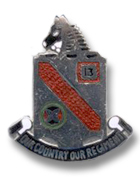 3rd Bn, 79th Arty DUI
3rd Bn, 79th Arty DUII served in USAREUR from 1960 to 1969. I was in the Operations Division of the staff for the first 18 months and for the last 18, I commanded an Honest John Battalion. My battalion was the 3rd Bn. 79th Arty. We were stationed in Giessen, attached to the 36th Arty. Group. We supported the 3rd German Corps that was headquartered in Koblenz. |
||||||||||||||||||||||||||||||||||||||||||||||||||||||||||||
| (Source: Email from Claude Barker, 3rd Bn, 79th Arty, 1962-64) | ||||||||||||||||||||||||||||||||||||||||||||||||||||||||||||
| I was in the 3rd Bn, 79th Arty in Giessen, Germany. LTC Pollin was my
Battalion Commander. I served with him from Jan 1962 to Jan 1964. We spent more time in the woods then any other outfit in Germany. We trained, trained, and trained some more. I remember some of the wives went back home (States) because we were always in the field. We were either getting ready for a inspection or going to the field. When in the field we ran fire missions night and day. Always looking for the chow truck, the cooks could never keep up with us. Sometimes we would eat 1 or 2 times a day; sometimes none. We were always cold and wet, because the weather was always bad. He slept in a tent, we slept in the open whenever we got to sleep. When we got back from the field, we worked every weekend always getting ready the IG, or some kind of "show and tell" inspection. After 2 years in the 79th I was a very happy camper when they said I could go home. |
||||||||||||||||||||||||||||||||||||||||||||||||||||||||||||
|
|
||||||||||||||||||||||||||||||||||||||||||||||||||||||||||||
| 3rd Battalion, 80th Artillery (Sergeant) | ||||||||||||||||||||||||||||||||||||||||||||||||||||||||||||
| 1960s | ||||||||||||||||||||||||||||||||||||||||||||||||||||||||||||
|
(Source:
Letter from Paul ..., 3rd Bn, 80th Arty, early 1960s)
|
||||||||||||||||||||||||||||||||||||||||||||||||||||||||||||
|
|
||||||||||||||||||||||||||||||||||||||||||||||||||||||||||||
| (Source: Email from Daniel Hatton, 3rd Bn, 80th Arty, 1964-66) | ||||||||||||||||||||||||||||||||||||||||||||||||||||||||||||
| Periodically, I surf to your website to see if there are any updates to information. I’m not sure how I can help or what you might be interested in receiving.
I served with both the 1/26th (about 2 months) and then the 3/80th FA on ELK (Ernst Ludwig Kaserne), Darmstadt, Germany from Spring 1964 until Summer 1966 (then assigned to a Hawk Missile unit in Key West, FL) until 1967. Gerda and I are now semi-retired, boat a lot here in San Diego, travel frequently, and still work part-time, but mostly life has been good & there’s no end in sight just yet! |
||||||||||||||||||||||||||||||||||||||||||||||||||||||||||||
|
|
||||||||||||||||||||||||||||||||||||||||||||||||||||||||||||
|
Related Links: |
||||||||||||||||||||||||||||||||||||||||||||||||||||||||||||
|
Babenhausen Kaserne - Lars Hagen has started a nice web site that covers Babenhausen Kaserne and the 36th FA Group in the 1960s.
The Red Scarf Club - This web site is dedicated to veterans, dependents and others associated with the 553rd Field Artillery Battalion at Darmstadt between 1956-1958) |
||||||||||||||||||||||||||||||||||||||||||||||||||||||||||||
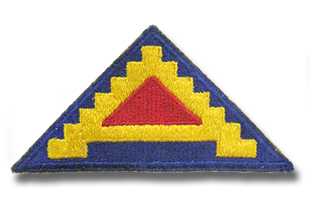














































































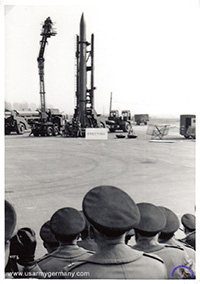

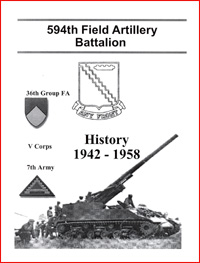










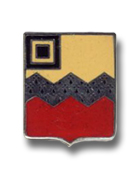 3rd Bn, 80th Arty DUI
3rd Bn, 80th Arty DUI